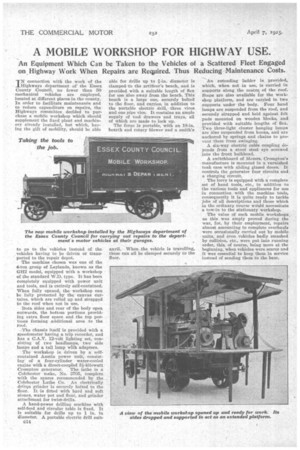A MOBILE WORKSHOP FOR HIGHWAY USE.
Page 18

If you've noticed an error in this article please click here to report it so we can fix it.
An Equipment Which Can be Taken to the Vehicles of a Scattered Fleet Engaged on Highway Work When Repairs are Rewired. Thus Reducing Maintenance Costs.
IN connection with the work of the Highways department of the Essex County Council, no fewer than 50 mechanical vehicles are employed, located at different places in the county. In order to facilitate maintenance and to reduce expenditure on repairs, the Highways committee decided to purchase a mobile workshop which should supplement the fixed plant and machinery already installed, but which, having the gift of mobility, should be able
to go to the vehicles instead of the vehicles having to be driven or transported to the repair depot.
The machine chosen was one of the 4-ton group of Leylands, known as the GH2 model, equipped with a workshop of the standard W.D. type. It has been completely equipped with power unit and tools, and is entirely self-contained. When fully opened, the workshop can be fully protected by the canvas curtains, which are rolled up and strapped to the roof when not in use.
Tot h sides and rear of the body open outwards, the bottom portions providing extra floor space and the top portions forming additional area to the roof. • The chassis itself is provided with a speedometer having a trip recorder, and has a C.A.V. 12-volt lighting set, consisting of two headlamps, two side lamps and a tail lamp with adapters.
The workshop is driven by a selfcontained Austin power unit, consisting of a .four-cylinder water-cooled engiue with a direct-coupled 31-kilowatt Crompton generator. The lathe is a Colchester make, No. 2705,. complete 'with the spares recommended by the CoIohester Lathe Co. • An electrically driven grinder is securely bolted to the floor. It -is fitted with bard and soft stones, water pot and float, and grinder attachment for twist-drills.
A hand-power drilling machine with self-feed and circular table is fixed. It is suitable for drills up to 1 in. in diameter. A portable electric drill suit c14 able for drills up to i-in. diameter is clamped to the artificer's bench, and is provided with a suitable length of flex for use also away from the bench. This bench is a large one, securely bolted to the floor, and carries, in addition to the portable electric drill, -three vices and one pipe vice. It contains an ample supply of tool drawers and trays, all of which are made to lock up.
The forge is portable, with an 18-in. hearth and rotary blower and a smith's anvil. When the vehicle is travelling, these can all be clamped securely to the floor. An extending ladder is provided, which, when not in use, is carried in supports along the centre of the roof. Steps are also available for the workshop platform, and are carried in two supports under the body. Four hand lamps are suspended from the roof, and securely strapped and held against felt pads mounted on wooden blocks, and provided with suitable lengths of flex. Two three-light cluster hanging lamps are also suspended from hooks, and are anchored by springs and chains to prevent them from swinging.
A six-way electric cable coupling depends from a stout steel eye screwed into the front bulkhead.
A switchboard of Messrs. Crompton's manufacture is mounted in a varnished teak case with sliding glazed doors. It controls the generator four circuits and a charging circuit.
. The lorry is equipped with a complete set of hand tools, etc., in addition to tire various tools and appliances for use in connection with the machine Viols, consequently it is quite ready to tackle jobs of all descriptions and those which in the ordinary course would necessitate a tow-in to the stationary workshop.
The value of such mobile workshops, as this was amply proved during the war, for, by their employment, repairs almost amounting to complete overhauls were occasionally carried out by mobile units, and even vehicles badly smashed by collision, etc., were put into running order, this, of course, being more at the beginning, when vehicles were scarce and it was essential to keep them in service instead of sending them to the base.




























